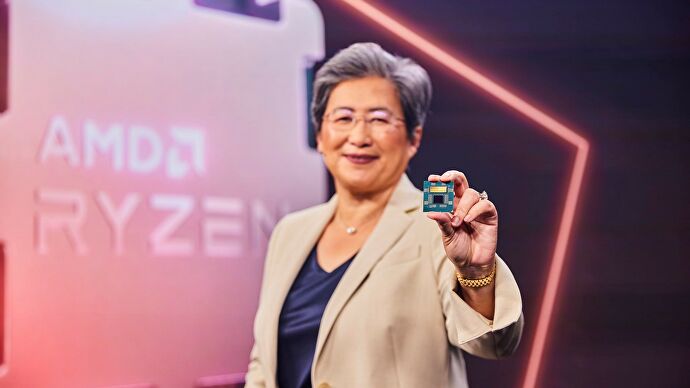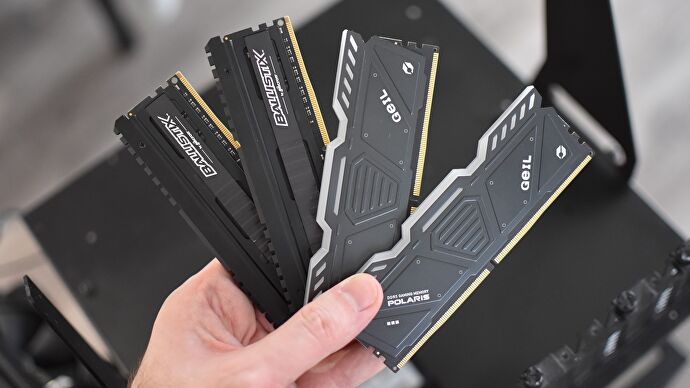AMD Ryzen 7000: everything we know so far

The AMD Ryzen 7000 family of CPUs is preparing for launch in 2022, two years after the Ryzen 5000 series. AMD have spent a good chunk of that time on its laptop chips, but back in the realm of desktops, Intel’s 12th Gen Alder Lake chips have leveraged major design improvements to beat the Ryzen 5000 series on performance and features. One suspects it would take a considerable rejigging for these Ryzen 7000 chips to get back into the best gaming CPUs conversation – and so far, that’s exactly what seems to be happening.
Now, AMD haven’t revealed all things Ryzen 7000 yet. There are no confirmed prices, for one, though we know roughly when the first batch of CPUs will release. For now, this is where I’ll be gathering all the reliably verified info on these next-gen components, from supported features and the new motherboard chipsets to those overhauled Ryzen 7000 specs.
Most of these deets are courtesy of AMD’s own Computex 2022 keynote, but I’ll be updating this page with fresh news as it appears. Feel free to bookmark it and check back if you’re likely to be in the market for a new CPU later this year.
AMD Ryzen 7000 release
Back during CES 2022, when AMD first made the Ryzen 7000 series officially official, autumn 2022 was given as a release window. As far as I tell, this hasn’t been pushed back since, though neither has it narrowed to a specific date.
For what it’s worth, the first Ryzen 5000 chips launched on November 5th 2020, though that doesn’t necessarily mean AMD are doing an Nvidia by releasing new hardware generations on a steady two-year cycle. Expect a more concrete release date as we get close to that September-November period, presumably along with pricing information, which is also still to come.
AMD Ryzen 7000 specs
The Ryzen 7000 design approach isn’t as unique as Alder Lake’s hybrid big-and-little core setup, but on paper it’s still a comprehensive upgrade on AMD’s previous work. More efficient 5nm chiplets will provide up to 16 of the new Zen 4 cores – replacing the Zen 3 cores that currently power such high-performing chips as the Ryzen 5 5600X.

Zen 4 cores will, in terms of stock, out-of-the-box clock speeds, be AMD’s fastest yet.. During Computex 2022, Dr Su showed a Ghostwire: Tokyo demo running on an unnamed Ryzen 7000 CPU, with clock speeds reaching as high as 5.5GHz. That’s on par with the Intel Core i9-12900KS, Intel’s fastest desktop CPU.
Ryzen 7000 also wants to take a cue from the Zen 3-based Ryzen 7 5800X3D. Instead of using monster clock speeds to crank up performance, this piles on extra L3 cache: when more data can be stored in the CPU’s own cache, it doesn’t need to read the slower system RAM as often, boosting speed overall. Ryzen 7000 will double its standard L2 cache size to 1MB per core, and while L2 cache is much smaller than L3, it does have higher read priority. Between this and the higher clock speeds, we could be very well looking at significant performance gains. AMD reckon single-core performance will be up to 15% faster on Ryzen 7000 hardware than on Ryzen 5000, though haven’t yet backed this up with games benchmark results.
AMD Ryzen 7000 features
The Ryzen 7000 range looks to be making up for lost time, stuffing itself with support for techy developments that have occurred since the Ryzen 5000 launch. DDR5 memory is one; I wasn’t too impressed with how this newer, faster-clocked RAM type performed when I tested it against DDR4 on an Intel 12th Gen chip, but it could copy DDR4’s trajectory by starting off slowly and gradually becoming much quicker (not to mention more affordable) over time. Speaking of DDR4, AMD haven’t actually made it clear if Ryzen 7000 will be compatible with both types, or just DDR5. I’ve contacted them and will update here if I get a solid answer.

The new CPUs’ PCIe 5.0 support will also open up potential for faster storage and graphics cards, as well as improved power delivery. Like DDR5, this is an upgrade with the future in mind, as consumer-grade PCIe 5.0 peripherals aren’t available yet, but for storage in particular it could be something worth having in your locker. PCIe 5.0 SSDs are likely to be much faster than even the best SSDs that use the PCIe 4.0 interface.
Another departure from Ryzen orthodoxy will be the inclusion of integrated graphics, specifically based on AMD’s existing RDNA2 architecture. Because Intel have added an onboard GPU to their desktop Core chips more often than not, AMD have typically reserved them for very specific Ryzens. With the Ryzen 7000 family, integrated graphics will be more of a standard feature. Does this make them a better deal when you’re likely going to be using a dedicated graphics card anyway? Unlikely, but it’s there if you want it. And AMD have confirmed that Ryzen 7000-ready motherboards – more on these below – will include the requisite HDMI and/or DisplayPort outputs too. These can be specced up to premium HDMI 2.1 and DisplayPort 2 standards, joining 20Gbps USB 3.2 2×2 connectivity on those rear I/O panels. I’ve seen rumors of 40Gbps USB4 support as well, though AMD have only mentioned 20Gbps speeds, so anything higher than that is looking unlikely.
During Computex, AMD also announced Smart Access Storage, which appears to augment Microsoft DirectStorage by further speeding up data transfers between the CPU, graphics card and compatible SSDs – the results being even faster load times and texture streaming than DirectStorage can manage by itself. Ryzen 7000 CPUs will support Smart Access Storage, and it sounds like older Ryzen chips will as well, though you’ll also need an AMD Radeon graphics card for it to work. DirectStorage isn’t up and running in any games at the time of writing, but that could well change by the time the Ryzen 7000 range launches in autumn.
AMD Ryzen 7000 socket, chipset and motherboards
RIP the AM4 socket, an AMD stalwart ever since it was introduced with the very first Ryzen CPUs in 2017. Ryzen 7000 chips will only fit in the new AM5 socket, though AMD have confirmed that any CPU coolers that fit AM4 will fit AM5 as well .
Still, even if you don’t need a new cooler to upgrade, you’ll certainly need a new motherboard. And naturally there’ll be new chipsets that the Ryzen 7000 CPUs will need to unlock all their features. Right now, we know of three: the ultra-enthusiast X670E, the high-end X670, and the mid-range B650. All three will support overclocking, as per Ryzen tradition, though the X670E and X670 chipsets will have more advanced features and controls for this purpose.
The chipsets also vary in the degree of PCIe 5.0 support they enable. Anything goes on the X670E, while X670 limits its PCIe connectivity to SSDs and graphics cards. On B650, it’s SSDs only.
As for specific models, AMD have confirmed the flagship X670E motherboards from various manufacturers: there’s the ASRock X670E Taichi, the Asus ROG Crosshair X670E Extreme, the Biostar X670E Valkyrie, the Gigabyte X670E Aorus Xtreme, and the MSI MEG X670E Ace. Again, we’ll have to wait a while for detailed pricing and release dates, though don’t worry about only top-tier mobos being available. Asus, for one, have confirmed they’re working on a number of X670 and B650 motherboards, across the more affordable ROG Strix, Prime and TUF Gaming sub-brands.
Reference-www.rockpapershotgun.com